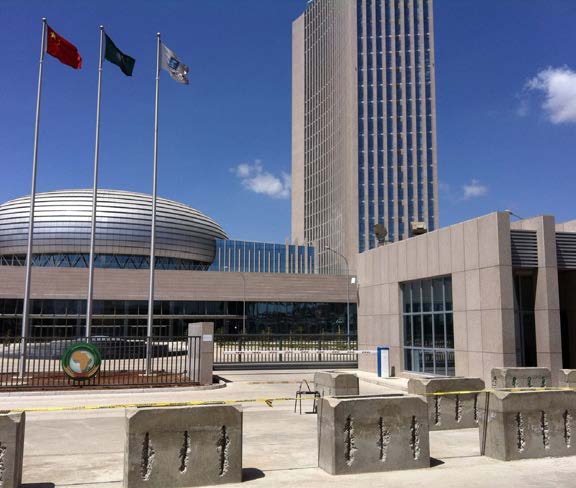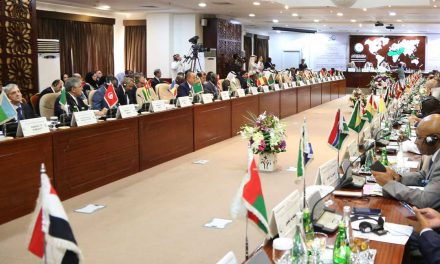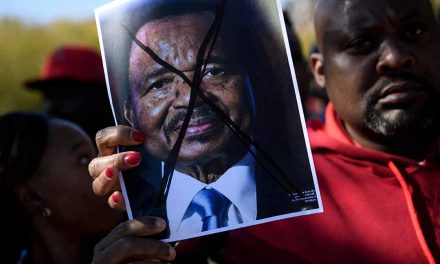
The $200 million AU HQ in Addis Ababa, Ethiopia © Albert Gonzàlez Farran/UNAMID
China’s presence on the continent may seem domineering, but its contributions to growth and security might be invaluable
China intensifying its engagement with the African Union (AU) is indicative of the extent of its activities across the continent. The AU Commission was officially admitted into Focac (Forum on China-Africa Cooperation) in 2011, and China opened an official mission at the AU in 2015. From Africa’s point of view,
China’s continued investment in the continent can be explained by the continent’s need for greater investment in transnational infrastructure and security. From China’s side, the investment is pragmatic as it allows China’s traditional bilateral engagement with African states to continue, while providing opportunities for more coordinated interaction across Africa.
China’s growing interest in large-scale, cross-border projects also dovetails with AU interests. An important AU aim is to achieve greater unity and solidarity between African states and through that, accelerate continent-wide political and socio-economic integration. Both parties stand to benefit.
In 2011 China presented the AU with a new headquarters, which cost a reported $200 million, in Addis Ababa. The move has been viewed in some quarters as symbolic of China’s increasing dominance on the continent. However, China donating the building should be situated within the broader global context of foreign assistance to the AU. China is but one of many countries that have strong ties with the AU. India, Turkey, the United States (US), Japan, France and Korea all have formal partnerships with the organisation. The recent Chinese mission to the AU joins other missions, including those of the US and the European Union (EU). In the light of this, China’s growing role at the AU should not be viewed as domineering, but rather as complementary to the activities of a host of other external actors.
Nevertheless, the exceptional growth of Chinese engagement with Africa over the past two decades should not be underestimated. The scale of China’s involvement in building schools, hospitals, commercial and industrial zones, bridges, dams, highways, railways, airports and telecommunication infrastructure is unprecedented. Along with this, it is shifting focus from activities within particular countries to an emphasis on transnational activity. In the past projects sometimes crossed borders, as with the Tanzania-Zambia railway line, but most projects were within a specific country and negotiated on a bilateral basis. But as Chinese infrastructure capacity on the continent makes headway, there has been a growing need to develop cross-border and regional infrastructure links. Indeed, various Focac action plans have highlighted the need for regional interconnectivity.
In 2015 AU chair Nkosazana Dlamini-Zuma and China’s vice-minister of foreign affairs, Zhang Ming, announced the signing of a memorandum of understanding around a continental transport agenda, including high-speed rail, aviation, road, highway, and industrialisation infrastructure. While specifics were lacking, the memorandum fits with China’s other lofty plans to connect Africa. These include the Three Networks and Industrialisation plan, as well as its much larger One Belt One Road initiative, which seeks to connect East Africa, the Middle East, Southeast Asia and Central Asia with Europe.
The AU has been keen to integrate itself into regional infrastructure projects in which China is a major player. For instance, in 2015 the Lamu Port Southern Sudan-Ethiopia Transport project was admitted as a Presidential Infrastructure Champion Initiative under the AU Commission. China is also increasingly engaging with the East African Community and the Southern African Development Community. Given China’s preference for bilateral interactions, its engagement with these multilateral institutions allows it to have its cake and eat it too.
The Chinese engagement with Africa is based on its insistence on bilateral relations. Engagement with larger blocs within the continent will not involve collective bargaining on the African side, as it does, say, with the EU. This allows China more flexibility in the deals it makes with individual African countries. African regional organisations are weak, and seldom speak with one voice. The opportunity to exert greater influence within multilateral bodies also enables China to initiate ambitious projects that require coordination across African nation states.
Strengthening this relationship has implications beyond transnational infrastructure. China has faced a steep learning curve on security over the past two decades, and Chinese involvement with the continent has faced resistance in Sudan and South Sudan. Sudan’s division in 2011 showed the Chinese the transnational dimension of political conflict in Africa. These conflicts often occur in regions — including the Horn of Africa, the Great Lakes region and the Sahel region — where China has significant commercial interests.
If we take China’s commitment to long-term engagement in Africa seriously, then it is in that country’s interests — as much as it is in African states’ interests — to ensure a peaceful environment in which to do business. It is within this context that the AU serves to leverage China’s interests in transitional situations. In 2015, President Xi Jinping announced a donation of $100 million to the AU to support the rapid response African Standby Force and the African Capacity for Immediate Response to Crises. He also announced the establishment of another standby force, comprising 8,000 staff, to function as a permanent peacekeeping squad.
China has also offered training and support for AU troops in ventures such as the AU Mission in Somalia and the hybrid UN/AU/Mission in Darfur. Through these and other measures, China is helping the AU to become an important vehicle with which to achieve regional stability. Additionally, Chinese support for other institutions, as with its assistance to United Nations missions in Africa, helps it to maintain its official stance of “non-interference” on the continent.
China’s increased engagement with the AU represents a pragmatic form of political and economic engagement that caters to the realities of African transnationalism. As more ambitious international projects arise, this will entail increased coordination through organisations such as the AU. It will also facilitate greater transnational interaction across the continent — as regards cross-boundary trade and transport, for instance. This will draw hinterland regions closer to national, regional and international marketplaces.
Meanwhile, China’s growing involvement in security in Africa, through the AU, will help to deploy troops within and across nation states to help achieve greater inter-regional connectivity across the continent.
In many respects China’s role in the AU reflects the challenge it faces with its broader One Belt One Road initiative, where it wants to implement infrastructure interconnectivity in politically unstable regions such as Central Asia and the Middle East. Its role in the AU, and what it learns from it, may offer parallels for its growing engagement in similar regional representative bodies in other parts of the world.












